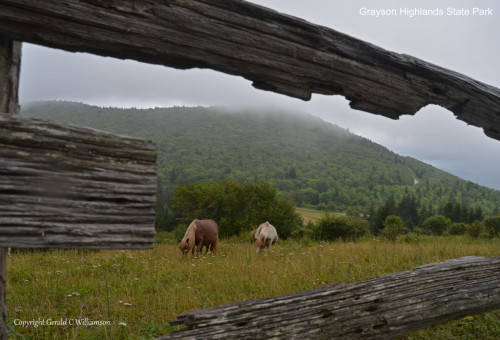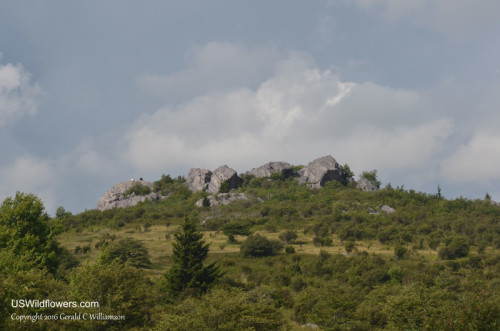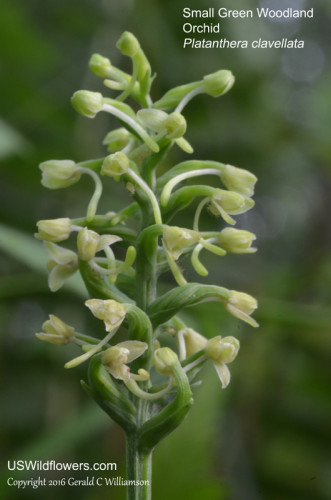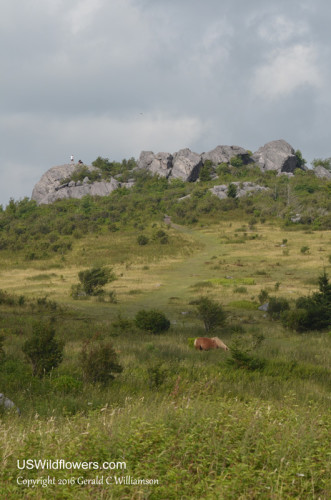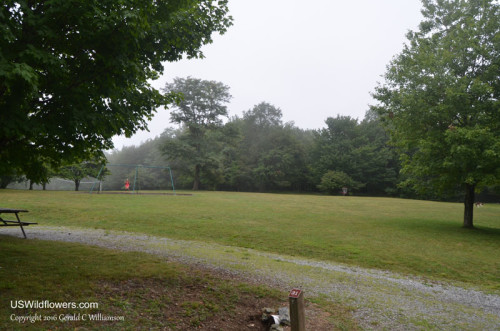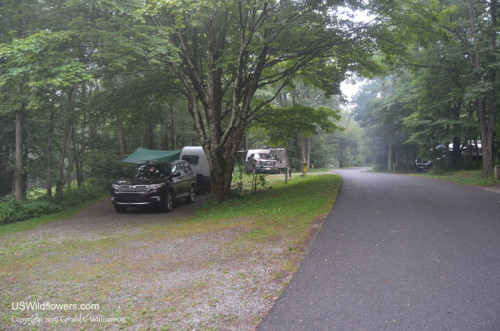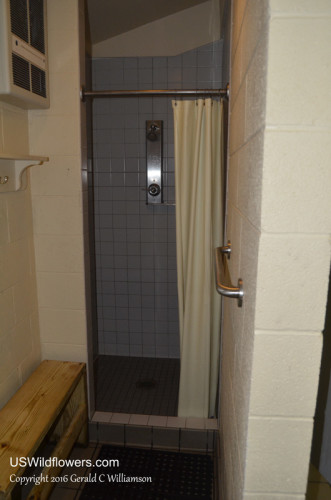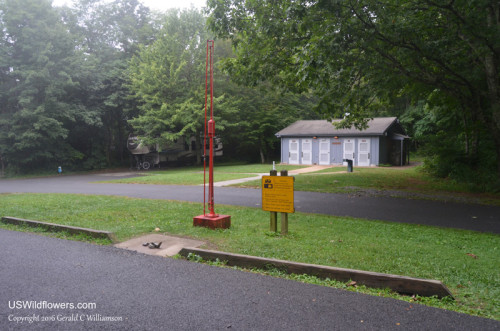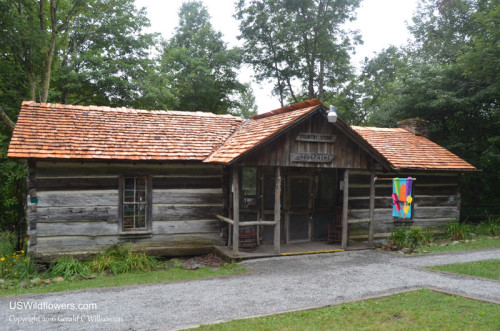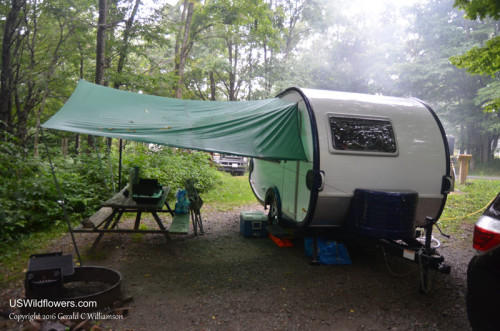Location / Name: Grayson Highlands State Park Hickory Ridge Campground, Mouth of Wilson, VA (Near Mt. Rogers)
Date: 08/01//2016 thru 08/05 (4 nights)
Grayson Highlands State Park came to my attention when I started rock climbing. I had heard it mentioned quite favorably several times in conversations in relation to bouldering, one form of rock climbing. On a trip to visit relatives in Roanoke, Virginia last year with my wife I wanted to swing by the state park to look it over, and we loved the ride up The Crooked Road and the wonderful views from within the park, so I knew then that at some point I wanted to spend a few days there in the campground. Things finally lined up and I was able to spend four nights there starting Aug 1, 2016. NOTE: Grayson Highlands State Park also has a horse campground that is not reviewed here.
General description of park/area:
Grayson Highlands State Park is located in the highlands of southwest Virginia, where it was established in 1965 on the flanks of Mt. Rogers, the highest point in Virginia (Whitetop Mountain, the second-highest peak in Virginia, is right next door to Mt. Rogers.) The elevation of the mountainous park is just shy of 3700’ at the entrance, and climbs to 4,953’ at the visitor center at the end of Grayson Highland Lane. The campground is probably about halfway between them at around 4300’. At this altitude it is usually much cooler than wherever most of us live – July, 2016 had 28 of 31 days above 90 degrees in Chattanooga, and the first week of August promised the same – 93, 88, 95, 95, 97 were the highs in Chattanooga while I was in Grayson Highlands; I don’t think it got above 80 while I was in Grayson Highlands, and on Thursday the high – the HIGH – was 64 degrees.
But it’s not only just the cooler weather that is the attraction for the park. This park has great views of the surrounding mountainous region, great hiking (the Appalachian Trail runs through a corner of the park), great wildflowers, wildlife, bouldering, and a herd of wild ponies. What’s not to love? There is an excellent picnic area down a beautiful side road, and for bouldering it doesn’t get much better than the picnic area – paved road, spacious parking lot, and a 75’ walk to a boulder (Rockhouse) with 8 routes ranging from V1 to V7. Not enough, 100’ from the other end of the parking lot is a boulder (Olympus) with 9 routes ranging from V2 to V9. Can you walk 150’? Another cluster with 14 routes from V0 to V6 (Picnic Blocks.) Keep going, Street Side Fins has another 5 routes from V0 to V5. Lots of climbing, right? Well, there are dozens of boulder clusters in the park with over 1,000 established boulder problems on them. I’m not a good boulderer, especially outdoors, and found the Warm-Up Wall along Listening Rock Trail to be right up my alley – a nice wall with nine V0’s on it where I was able to spend a few really fun hours abrading my fingertips on the granite surface (no, don’t think polished granite like your countertop.)
Be sure to take a walk up the Rhododendron Trail (even if you’re not going to climb in the Highlands Area) and you’ll likely get glimpse of the wild ponies that live in the park and the adjacent Mt. Rogers National Recreation Area. You’ll also get some great views, assuming you’re not in the clouds (I had it both ways.) Be sure to prepare for very changeable weather – you should take some rain gear, water, and other ‘standard’ hiking equipment with you. Wildflowers abound along this trail, and from it you can reach Sullivan’s Swamp, one of the increasingly rare high mountain seap bogs, which can provide really interesting botanical specimens.
The park also has some really nice activities led by some really nice park staff. I attended a little seminar with a couple of other campers that was held at the campground amphitheater where Education Support Specialist Amelia Hulth taught us some medicinal values of some common yard and garden “weeds” (English Plantain, Mullein, Red Clover, White Clover, among others) and then helped us identify some plants and flowers that were growing in the immediate vicinity.
The address of the park is 829 Grayson Highland Lane, Mouth of Wilson, VA 24363, in case you need it for your GPS.
General description of campground:
The 72-site campground is a convenient way to stay for a visit to all the treats Grayson Highlands State Park provides. The campground is clean and well-maintained, and easy to access – assuming you’re willing and able to bring your vehicle on a winding and at times steep road. The picnic tables are aging a bit, and many of the sites are a little smaller and closer than I’d like, but all in all a very nice campground. The bathhouses are the best I’ve used in a state park so far (see the description later), and the staff and campground hosts are helpful and friendly. Most sites are well-shaded, although a few on the inside of the upper loop – sites 31, 32, and 34 at the beginning and sites 66, 68, 70, and 72 at the end – have shade that’s a little sparse (or maybe almost non-existent.) With the cooler temps this might not be a problem except on the hottest days. I was disappointed to find that you can’t have both a camping trailer and a tent on the same site. Those of us with smaller trailers frequently count on having a tent to house a kid or two if we bring them along. Not only is that forbidden (I think!) but there didn’t seem to be room in most sites to have a tent and a trailer, and the RV sites did not also have a tent pad. A number of sites (including mine, #37) didn’t really have trees that were well-positioned for hammocks.
There is a playground in the grassy commons area that includes a swing and I think a slide, as well as at least one disc-golf goal, horse-shoe pit, and volleyball court. Bicycles were popular while I was there, but some of the hills within the campground are somewhat steep, so there were a lot of people off their bikes pushing them. For the climbers, there are some nice boulders with established problems just yards away from the campground.The campground store is picturesque and will supply your need for snacks, souvenirs, and some basic camping supplies.
Access: Grayson Highlands State Park is nearly 40 miles from I-81 exit 19 in Abingdon, VA via US Highway 58, and about 35 miles from I-81 exit 45 in Marion, VA via State Route 16 to US58, then US Highway 58 west to the park. US Highway 58 from 16 to Damascus is also known as Highlands Parkway, Jeb Stuart Highway, and The Crooked Road. The road from Damascus to the park is a VERY crooked road, and quite beautiful to drive if you are not in a hurry. The roads accessing and within the park are in excellent condition, although all are somewhat curvy and steep. There should be no problems with access in any kind of vehicle. The roads through the campground are easily managed by vehicles of pretty much any size – there was a 40-foot (my estimate) motorhome in the park, and quite a number of large 5th-wheels. Some of the sites might be a fair walk from the bathhouse. The park closes at 10 PM, but I don’t know the status of gates at that time. I don’t think the campground gate closes (but didn’t verify) but suspect the main park gate does close at 10 PM and opens again at 6 AM.
Site: I stayed in Site #37, a pull-thru site in the upper loop. Many (most RV) sites in the campground are pull-thru, and the back-in RV sites are angled well enough to make back-in fairly easy. The roads through the campground are paved, the driveways and tent pads are gravel. There will be some leveling required on most sites; some sites quite a bit. I needed to raise one side of my trailer by 3 lego blocks to get level. The site surface does not lend oneself to clean feet when it rains.
The sites are adequately roomy, but there is not a tent pad in the RV sites. Since they do not allow a tent and an RV on a single site that isn’t a problem if you have an RV, but don’t get an RV site if you are in a tent; there might not be a large enough level area for your tent. This also seems to be a problem for those of us with a small RV and may want to bring kids staying in a tent. The sites are limited to 6 people (or 1 family) per site. There is a large wooden picnic table, a fire ring with grill, a lantern post, and the electric pedestal and water spigot in each RV site. Tent sites don’t have water or electric (perhaps some do; I didn’t see any in my walkthru.) While there are many trees in the campground, and large areas within the loops, there isn’t a lot of understory between the sites, so privacy should not be expected. This is further complicated because many of the sites are end-to-end pull-thru with the exit driveway sharing access to the road with the entrance driveway of the next site..
Electric: 20/30 amp at RV sites. For the first time I used an analyzer/surge protector, and the 30-amp pedestal passed the tests. It did not test for high/low voltage. The pedestal was within easy distance of my 25’ power cord, with plenty to spare if I wanted to rearrange. There are four sites with 50-amp service; the tent sites do not have electricity.
Water: Water connections are available at the RV campsites, and there are variously-located water hydrants available to the tent sites. I used a pressure reducer, but didn’t check to see if it was needed. The hydrant in the site was conveniently located within easy distance of my trailer using my 25’ hose.
Bathhouse: The bathhouses are a definite strong-selling point for this campground. There are two bathhouses in the campground, one per loop, as well as a toilets-only bathroom at the campground entrance near the “Country Store.”. All bathhouses are handicap-accessible. I didn’t enter the one in the lower loops, but I imagine it is similar to the one in the upper loop. The bathhouses were well-lit and reasonably clean (the campground was busy, and it had rained, so someone would need to be mopping full time to prevent the leaf-strewn tracks), and they were nicely appointed. There is a single urinal and two toilets in the men’s (presumably three toilets in the women’s.) There are three single sinks with hooks, shelves, and soap dispensers between them. There is a hand-dryer – an Xlerator, so you know it will do the job. There is also a changing table in each bathhouse. There is a trash can in the entrance foyer to the bathroom.
The showers at Grayson Highlands are deservedly well-known with a thoughtful design. First there is a shower area within the main bathroom, and there is an additional shower with a separate entrance outside the bathhouse. This not only provides 2 showers per gender, but makes the two outside rooms a lockable shower – great for those that might want some extra privacy, but with a lockable door provides extra security for those that might need it. In each shower the dressing area is separated from the shower area by a curb and a curtain to keep the spray in the shower. The dressing area has a mat to allow you to stand out of the water if some did make it into the dressing area, it has a bench, several hooks on which you can hang your towel and clothes, and a spacious shelf. The shower stall itself is roomy, tiled, and clean. The shower head can be pointed in all directions as needed, and the temperature adjustment is vast – you can have a cold shower if you want, or you can get it really hot. I found that hot shower great for relaxing those sore muscles after a climbing session. The showers are available for $5 to folks who are not registered campers.
The bathhouse also had a dishwashing station with two sinks and large counter space. Presumable you can bring your gray water here for disposal as well.
Sewer: No sewer at sites; but there is a dump station across the road from the upper loop bathhouse. While I didn’t use it, this dump station seemed well-designed and easily accessed. Rinse water is available at this location.
Cell Phone Service: I had various reports of the availability of cell service at the campground from a ranger and another camper – the ranger had US Cellular service which worked. The camper had AT&T service which did not. I have a Verizon phone, and I got no signal at times, but most of the time in the campground I had a single “extended” bar – roaming, and voice calls didn’t work. Text messaging worked most of the time – I had to resend about 1 in 4 messages. My 4G hotspot had no service. However, about 2.5 miles from the campground, at the Sugarlands overlook you pass as you climb the mountain from the entrance, I got 3 bars roaming signal on my phone and was able to make voice calls, and I got a 3-bar 4G Verizon connection on my hotspot, so I was able to get Internet service for my Kindle and my laptop when I was willing to make the drive. The views from this overlook are great, so if it isn’t raining or in the clouds (as it was for much of my visit) you get an extra bonus visiting this overlook.
Trash disposal: Dumpsters are located next to the dump station in the upper loop, and near the entrance to the campground. I think I saw a dumpster near the lower-loop bathhouse, but don’t see it on the campground map, so maybe I’m mistaken. The dumpsters have sliding doors to open into which you toss your trash bag – assuming it isn’t full. On Monday night or Tuesday morning when I took my first bag of trash I had to be careful to keep the overflow from falling out when I pressed my bag in, but apparently the dumpster was emptied Tuesday, so there was no subsequent problem. There are standard metal trash cans labelled for recyclables at each dumpster. I remember seeing bear-proof trash cans somewhere in the park, but they didn’t seem to be a standard feature, so I assume bear visits are rare.
Cost: Here Virginia works at making me think twice about a return visit to their state park system. The prices are relatively high, and they give no senior discount. Walk-up prices for non-residents are $40 per night (that’s commercial campground level) for a site with water/electric ($35 for residents) and $29.00 per night for a site without water/electric ($25 for residents.) Online it’s a little different. There are 8 RV sites and 8 tent sites which can be specifically reserved (and marked with yellow site signs.) The remaining 64 sites (34 tent, 26 30-amp, 4 50-amp) are not specifically reserved – you are guaranteed a site, but you just pick from the remaining non-specific sites when you arrive. (Some of these non-specific sites are among the better sites, but you have no guarantee that a particular site will be available. In my walk-thru I only saw one or two sites that were “bad” – and these because it seemed it would be too difficult to get level.) Here are the online reservation prices:
- 30-amp RV site-specific $33 resident; $38 non-resident
- 50-amp RV non-specific $30 resident; $35 non-resident
- 30-amp RV non-specific $30 resident; $35 non-resident
- Tent site-specific $23 resident; $27 non-resident
- Tent non-specific $20 resident; $24 non-resident
- Nov, Mar, Apr non-specific only (Electric, no water, no bathhouse) $15 resident; $18 non-resident. The campground is closed Dec – Feb.
In addition there is a $5 transaction fee and state sales tax. I wanted to know what I was getting so I reserved a specific site (I could have gotten a decent non-specific site when I arrived on Monday at 2:30, saving $3 per day, but who knew?) Add the $5 transaction fee and $8.06 tax and I paid $165.06 for four nights. In comparison, I paid $69 for four nights at Indian Boundary Recreation Area a few months ago. It was early $100 more four 4 nights at Grayson Highlands for nicer bathhouses and not-as-nice sites. Remember that Virginia doesn’t give a senior discount. Tennessee state parks start out less expensive (example: $27.50 at relatively nearby Roan Mountain State Park) and they give a 50% senior discount. Many Tennessee State Parks have wifi available. At Vogel State Park in Georgia the price for an electric/water site is $30; with Georgia’s 20% senior discount I paid $24 per night. I’m not saying it’s not worth it – the overall Grayson Highlands State Park is great – but I’m not going to call the campground a “best buy” in spite of the excellent showers.
Supplies/Food: There is a campground store (“Country Store”) near the entrance to the campground that carries a good variety of souvenirs, snacks, and books (nature guides.) It also has a fair selection of basic needs for campers as well, but don’t count on this being the place you “supply up.” The park’s Country Store is open mid-May through mid-October. The Grayson Highlands General Store and Inn is about 6 miles away from the campground on Highway 58 east of the park, and it advertises itself as having groceries, camping supplies, fuel (including propane), and a deli. There is a Food City grocery store in Damascus about 30 miles west on Highway 58 (and Damascus would have everything else you should need), but that’s via the Crooked Road, and will take about an hour to drive it. Bottom line – have your supplies when you arrive.
T@b Note: It’s a little over 290 miles from our home in north Georgia to Grayson Highlands State Park. Towing my T@b trailer with my 2012 Toyota Highlander Limited (4WD, 6-cylinder). I traveled I-75 and I-81 to Abingdon, VA, 245 of those miles, getting 16.3 MPG by staying mostly between 60 and 65 MPH. The remaining 45 miles of curvy, climbing route from Abingdon to Grayson Highlands Campground put a ding in the gas mileage, and the overall trip to the park from home was 15.8 MPG. On the return trip – a net downhill from 4200’ to 900’ elevation over the 290 miles, I got 16.5 MPG using the same route.
I didn’t need air conditioning in the T@b even though it was August due to the cooler weather at the high elevation, except for twice – when I first got there I left the shade on the west-facing awning up, and the sun heated the cabin above comfort levels, so I ran the A/C for about 30 minutes to cool it down, and on the last morning I ran it for about 30 minutes to try to dry out the humidity from the 36 hours of rain we’d had. I also ran the heat for an hour or so the prior evening for the same reason; it was cool, but not uncomfortably so, but the humidity also made it clammy. Towels and clothes weren’t drying out, so I wanted to reduce the humidity. I also wanted to blow out any insects that might have set up housekeeping in the Alde exhaust pipe over the summer.
I got to use my tarp/awning for the first time this trip. I had put together some Keder-rail clips for a 10’x12’ tarp I’ve had for years, and had purchased some tent poles so I could use the tarp as an awning. It fit nicely over the picnic table, and kept the ground outside the trailer mostly dry – the level part of the campsite was also the low spot, so the rain didn’t drain away from the site as well as I would have liked. I did have to adjust my corner-ties on the tarp. The outside corners really need to be anchored from two directions so the pole can be pulled both away from the trailer and along the end-line of the tarp to keep it taut. Perhaps a single line will do if it can be tied very closely to a 45-degree angle from the tarp edges. I also needed to tied the 2nd grommet on the edge leading away from the trailer to the handle on the corner to straighten a sag that allowed rain to puddle in the tarp. The only real “problem” however was with the clips I designed. They are a panhead screw held to a corner bracket with a pair of nuts, and a small carabiner clipped into the corner bracket. The screw/corner bracket combo are about 1” long, and the inside dimension of the carabiner is another 2”, so the tarp is held at a minimum 3” away from the side of the T@b. This allowed more rain than I expected to get through. I had a coffeemaker sitting on a cooler alongside the T@b under the window on that side, and it got wet overnight. That problem was resolved by opening the window widely, providing shelter from the rain, but the runoff from the window then went into the tarp-protected space. I need to figure a way to shorten the distance between the tarp and the trailer while still allowing easy removal of the hardware from the tarp.
With the tarp I did most of my cooking outside on my Coleman stove/grill. That worked nicely.

